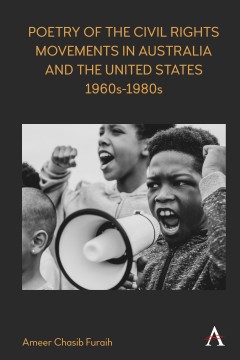Poetry of the Civil Rights Movements in Australia and the United States, 1960s–1980s
By Ameer Chasib Furaih
Other Formats Available:
E-Book- About This Book
- Reviews
- Author Information
- Series
- Table of Contents
- Links
- Podcasts
About This Book
The book scrutinizes the poetries of Oodgeroo Noonuccal (1920–1993), Lionel Fogarty (1958– ), and Amiri Baraka and Sonia Sanchez (1943– ), focusing on their relatively comparable sociopolitical, and literary concerns and aspirations, though they are ethnically diverse and geographically dispersed. What I have attempted to do here is an integration of their idiosyncratic differences. This objective is grounded upon the fact that the role of poetry in this struggle and the international connections between the political movements in which these poets were involved have been overlooked in historical narratives of Australia and the United States, although Aboriginal and African American representation in the political narratives did improve during the 1960s. In fact, these poets not only merged writing poetry with a commitment to their peoples’ political activism, but also actively participated in their peoples’ political activism. They collaborated with other civil rights activists and participated in rallies and demonstrations. Sanchez and Fogarty are still involved. In their poetries, they recorded their peoples’ pathos, injustices, social needs and political aspirations. Therefore, the book’s confluence of poetics and politics is original because it aims to demonstrate how these poets voice the demands of their peoples, and how they use their poetries to reflect the realities they experienced during this period. Additionally, the book demonstrates how these poets resist cultural and linguistic hegemony and how they adapt their peoples’ cultures and languages in their poetries to oppose literary universalism.
Instead of tracing the general development of Aboriginal and African American poetries during this period, I narrow the scope of my research to the poetries of these four selected poets, placing their works in broader, international contexts by drawing trans-Pacific connections between their poetries. The contribution of this book lies in its study of poetic intertextuality and common themes, and in the evaluation of the impact (direct or indirect) of African American poets, particularly those of the Black Arts movement, upon Aboriginal poets. Thus, the book should be seen as a starting point, rather than the final word on transnational exchanges between these movements. It should be noted that the poets I have chosen are not a comprehensive selection of Aboriginal or African American poets. Moreover, by selecting 1960s and 1980s as historical makers in the title of this book, my aim is not to narrow the scope of my research to the poetry publications of these poets to these decades, as, for instance, Oodgeroo began writing in the 60s and continued till her passing in 1993, and Fogarty began writing in the 70s and continues to the present, nor to limit these poets’ political and literary activism within this period, as Fogarty and Sanchez still involved in their peoples’ political activism. My intention is to demonstrate how these decades are significant in the literary and political developments of Aboriginal Australian and African American peoples, showing the role of many international sociopolitical and cultural upheavals, which took place during the 1960s, in shaping the literary and political ideologies of these poets.
I have treated the poetries of these poets as an example of distinct poetics, which is not bounded by the borders of a territory or by geography as abstracted on a map, situating them along the lines of what Chadwick Allen (2012) calls “together (yet) distinct”. This literary-political relation enables the poetries of these geo-ethnically distinct poets to be read within a single critical frame, and we can place their poetries as part of a larger, international revolutionary ‘Black’ literary movement. As such, this book helps to identify a significant trans-local connection to add to the already existing connections between Australian Aboriginal politics and poetics and those of First Nations peoples across the globe. This synthesis can also be seen as a way to remap Aboriginal and African American literary discourses as well as mainstream anticipation of them and their pre-established literary positions. This book also invites the dominant critical studies to consider the new literary approaches adopted by these minorities, which challenge the individualistic literary genres and narratives in both countries. It is hoped that the synthesis of these geo-poetically diverse poets may stimulate further literary investigations in the field of Aboriginal and African American poetries.
Reviews
“Ameer Chasib Furaih is to be congratulated for his masterful contribution to forging transcontinental cultural links between Aboriginal Australian and African American literatures. This is the kind of global network that matters among peoples fighting for cultural and political autonomy, and he makes a compelling case for how this network is strengthened through literary activism.” — Stephen Muecke, Nulungu Research Institute, Broome, Western Australia
“Poetry of the Civil Rights Movements in Australia and the United States engages an important era of grassroots activism and poetic experimentation from which we still have much to learn. The book’s purposeful juxtapositions productively situate Indigenous Australian responses to settler colonialism within transnational and global contexts.” — Chadwick Allen, author of TransIndigenous: Methodologies for Global Native Literary Studies
Author Information
Ameer Chasib Furaih is an instructor at Baghdad University/ College of Education (Ibn Rushd) for Human Sciences.
Series
Anthem Studies in Australian Literature and Culture
Table of Contents
Acknowledgments; Foreword; 1. Introduction; 2. Transpacific Political Connections; 3. Oodgeroo Noonuccal’s Interdisciplinary Poetics (1920–1993); 4. Amiri Baraka and the “Saturation of Blackness” (1934–2014); 5. Sonia Sanchez: Between Black Nationalism and “Womanist” Poetics (1943–); 6. Lionel Fogarty’s Multivalent Identitarian Poetics (1958–) 7. Conclusions; Appendix A: A Final Note about the Interview; Appendix B: Ethical Clearance; Approval Form; References; Index
Links
Stay Updated
Information
Latest Tweets



